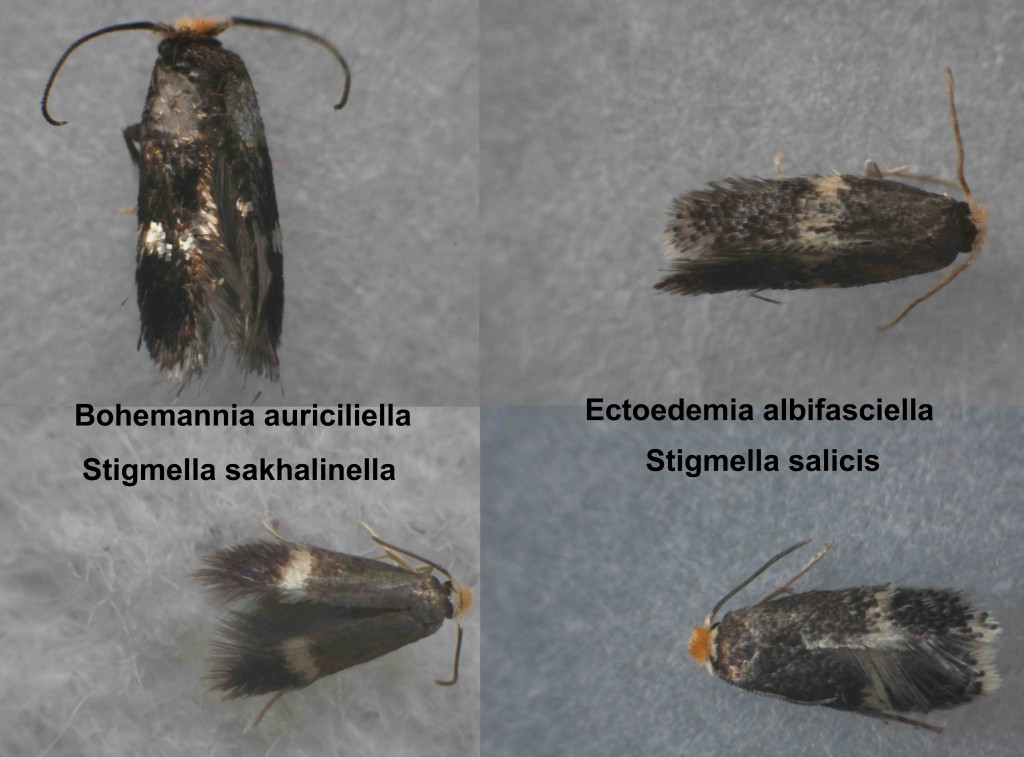I have not been trapping particularly intensively at home and whilst Matthew has been busy elsewhere than the Hollesley Marshes I have paid visits to Staverton Park (16th) and the Tangham area (12th and 21st). My best catches have been in the micros but have had some nice macros too. At home the dominant species are Heart and Club, Uncertain and Dark Arches. Rustic has appeared recently too. Hawk-moths especially Privet and Elephant are routine and I have finally picked up the Pine at Tangham and interestingly a Lime at Staverton Park. Staverton Park provided the lovely Blotched along with the Large and Common Emeralds and a truly melanic Riband Wave. There were also 4 Grey Arches and a Miller. Several Red-necked Footman at Tangham (definitely resident in Suffolk). At home a second Rosy Wave, a recent Rufous Minor and my first Large Nutmegs.
The striking, though small, Eulamprotes wilkella has been frequent at home and Tangham. Archips xylosteana was abundant at Staverton Park which along with A. podana and Ditula angustiorana made identification a little confusing. I was pleased to turn up a Spatalistis bifasciana there too which adds weight to the argument that the species is associated with oak and not the berries that they were previously thought to feed on. I was then exited to see a ‘little runner’ (as I call the Tinea related group of micros) that I didn’t recognise. It proved to be Niditinea striolella. Quite a scarce species and a first for the county. Then at home I managed to pot one of the little runners in my roof space that was associated with the mouse remains there. This was N. fuscella (not so scarce!).
Had a good selection of Argyresthia species, mostly on my travels. The very attractive all metallic A. goedartella was common at Staverton along with the variable A. brockeella and a glaucinella and retinella. Tangham has provided A. pygmaeella and what now appears to be the ubiquitous A. cupressella. As anticipated Tangham has also been turning up a good range of conifer feeders. Rhyacionia pinicolana, pinivorana and buoliana are all present.
As usual I do identify my Coleophora species. This has mostly turned up commoner species but I have taken a C. adjunctella at home which is a scarce salt-marsh species and has one other Suffolk record 110 years ago according to The Moths of Suffolk. C. milvipennis is frequent at Staverton where I also picked up a serratella and glaucicolella but Tangham has provided the most interest with a good range of species. In particular one which I believe is the scarce C. alnifoliae. This species is very similar to 3 other species and the dissection shows only slight differences. I am happy that the moth matches but would like expert opinion for a confirmation on the genitalia prep. If you have this expertise please follow the link https://groups.yahoo.com/neo/groups/mothdissection/photos/photostream/lightbox/1838660890?sortOrder=desc&photoFilter=ALL&orderBy=mtime#zax/1838660890 . I also took both species of Tischeria there; dodonaea and ekabladella.
Finally I have been identifying the Nepticulidae I catch, having obtained suitable literature. This year they have recently included Stigmella sakhalinella, salicis, svenssoni, roborella and samiatella, Ectoedemia albifasciella and quinquella, however the best one turned up at Tangham. A large (for a nep) species stridently marked with loosely scaled turned out to be Bohemannia auriciliella. Clearly a first for Suffolk but also appears to be only the sixth for the UK. Being thought to be a birch feeder it is likely to be resident in the Tangham area.


Very good work indeed, Raymond! Regarding Spatalistis bifasciana according to the Field Guide to the micro moths of Great Britain and Ireland the species feeds on withered leaves of deciduous trees, including, Sweet Chestnut and Beech both of which were abundant at Ashby Warren where we got it on Sunday